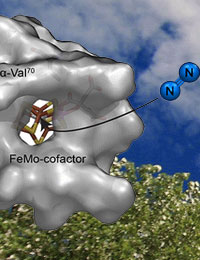Navigating the Nitrogen Passage
Scientists discover channel used by catalyst to produce ammonia, vital for food and fuel crops
(May 2014)

The open conformation of the nitrogen channel in a molybdenum-dependent nitrogenase. Enlarge the image to see a side-by-side comparison of the open and closed forms.
Results: Mother Nature's helper in turning nitrogen from the air into ammonia is an enzyme called nitrogenase that uses molybdenum and iron; scientists want to learn natural catalyst's secrets and apply them to synthetic catalysts. To do so, they first need to know how the nitrogen gas reaches the heart of the catalyst. While scientists have posited long, convoluted routes, a team from Pacific Northwest National Laboratory and Utah State University discovered the actual channel the nitrogen uses. It is short and direct. They discovered the channel by identifying groups of proteins on the catalyst's surface that guard access to the metal atoms, twisting aside to allow nitrogen in.
"Our channel is the only one anyone has seen in action," said Dr. Simone Raugei, a theoretical chemist at PNNL who worked on the study.
Why It Matters: Producing ammonia for use in fertilizer is an energy-intense reaction, known as the Haber-Bosch reaction, that requires high temperatures, around 500 degrees Celsius. The reaction consumes hydrogen gas derived from fossil fuels. Nitrogenase takes fundamentally different process to produce ammonia, and this natural reaction happens quickly at room temperature. If a synthetic catalyst could be designed that operates efficiently at room temperature and consumes available protons and electrons instead of hydrogen gas, it would greatly benefit both the agricultural and energy sectors. The discoveries made in this study provide vital information for designing such catalysts.
"We knew where the reaction happened," said Dr. Dayle Smith, a computational chemist at PNNL who conducted the study. "But, we didn't know how the nitrogen got there. Now we do."
Methods: The researchers modeled molybdenum-dependent nitrogenase, a fast, efficient, and prevalent enzyme. The natural catalyst drives a reaction that turns one nitrogen molecule into two ammonia molecules. The reaction happens at the active site, buried deep inside the molecule. To access the metals at the active site, nitrogen gas must traverse channels from the surface to the active site.
Previously, scientists suggested three possible channels that directed the nitrogen to the active site. Each of these channels was long and convoluted. To determine the actual channel, the team ran submicrosecond atomistic molecular dynamics simulations using a supercomputer at EMSL. The simulations provide the location and trajectories of each atom as the enzyme catalyzes the reaction.
"Being able to see how the atoms move-you can get a lot out of that," said Smith.
In analyzing the data, the team found the channel was short and not far away at all, but rather close to where the chemistry happens. The channel is covered by protein groups on the surface that act as flaps that open to allow the nitrogen to enter.
"Nobody could see it before because you had to have the protein moving to see it," said Smith.
The team further analyzed the viability of the channel by studying the energy required for the nitrogen to move through the catalyst. Their calculations showed that nitrogen uptake occurs along a low-energy path.
What's Next? The team's next steps include determining how other small molecules enter and exit the catalyst.
Acknowledgments:
Sponsor: U.S. Department of Energy (DOE) Office of Science, Basic Energy Sciences, Chemical Sciences, Geosciences and Biosciences Division and a separate DOE Office of Science grant (LCS)
User Facility: EMSL for computational resources
Research Area: Chemical Sciences
Research Team: Dayle Smith and Simone Raugei, Pacific Northwest National Laboratory; Karamatullah Danyal and Lance C. Seefeldt, Utah State University
Reference: Smith D, K Danyal, S Raugei, and LC Seefeldt. 2014. "Substrate Channel in Nitrogenase Revealed by a Molecular Dynamics Approach." Biochemistry 53(14):2278-2285. DOI: 10.1021/bi40131
